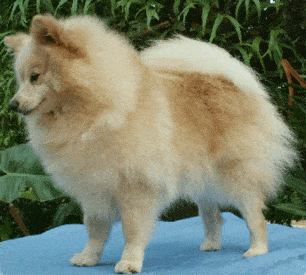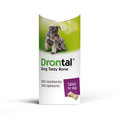
This article also relates to: American Eskimo Dog, Japanese Spitz, German Spitz (Klein) and German Spitz (Mittel)
The German Spitz Klein and the German Spitz Mittel are two distinctions of the oldest dog type, with fossil remains and ancient records indicating that the Spitz dates back to the early Stone Age. This is contested by modern genetic evidence, which places the Spitz in an even older lineage. The breed was traditionally developed to guard property and protect its masters. The Chow Chow and Akita can be traced back to the Spitz family, despite being classed as separate varieties. Introduced to the United States by German immigrants, the German Spitz was entitled the 'American Eskimo Dog' in 1917 due to anti-German feeling during WWI, and was categorized as a non-sporting 'utility' breed by the American Kennel Club. In the 20th century, it was also widely employed as a circus performer.
Perhaps the only immediate difference between the Spitz Klein and the Spitz Mittel is size-related, with the Mittel being slightly larger than its brother. Otherwise, there should be no notable distinctions between the two variations, in shape or in characteristics. No restrictions are placed on colour, with common variations seen in white with cream or biscuit markings. The German Spitz is classified by three sizes, including Standard, Toy and Miniature. Boasting a proportioned body with a thick, double coat, straight legs, a high-set, plumed and curled tail, and triangular ears. The Spitz is a notorious barker, in line with its guarding heritage, so training from an early age is essential with this breed.
Independent-minded, vigilant and agile, the modern Spitz maintains its original characteristics, inclining it to guard and protect. This by no means suggests the breed is anything but gentle, affectionate and mannered with its family, devoted to children and obedient to instruction. The average weight of a healthy German Spitz will vary depending on its size, although it can be anywhere between 2.5-16 kg, with a relatively long life expectancy of 15 years. It is not uncommon for a Spitz to outlive this expectancy when cared for accordingly.
Typically healthy, resilient and long-lived, the German Spitz is not prone to any known genetic diseases. As with any breed, the Spitz might be susceptible to hip dysplasia, skin allergies and optical disorders. As a breed it gains weight easily, so feeding human foods is not encouraged for this reason.









Sehr geehrte Kunden von VioVet Deutschland,
Ab dem 31. Oktober 2018 ist die viovet.de Webseite nicht mehr aktiv und die VioVet GmbH stellt den Handel ein. Wenn Sie dennoch bei VioVet Ltd (UK) einkaufen möchten, können Sie ein neues Konto bei viovet.co.uk erstellen. Wenn Sie Fragen zu einer Bestellung haben, die Sie auf viovet.de aufgegeben haben, dann kontaktieren Sie uns bitte hier [email protected].
Die viovet.co.uk-Website ist derzeit nur auf Englisch und in GBP (£) verfügbar aber unser Team arbeiten in den kommenden Monaten daran, Sprachen und Währungen hinzuzufügen.
Wir möchten uns ganz herzlich für Ihre Treue als Kunde bedanken.
Mit freundlichen Grüßen,
Ihr VioVet Deutschland Team
From Gloucestershire, United Kingdom
German Spitz are very loyal and usually a one person dog, they are very intelligent, very friendly and loving, and do not have doggy smells, they are a beautiful dog.
From United Kingdom
Japanese Spitz do not have the same temperament and personality as a German Spitz.
From Hampshire, United Kingdom
Our spitz is very very goid with kids and baby's
Very gentle, but does jump with excitement as was not trained from a puppy,
He guards the house well